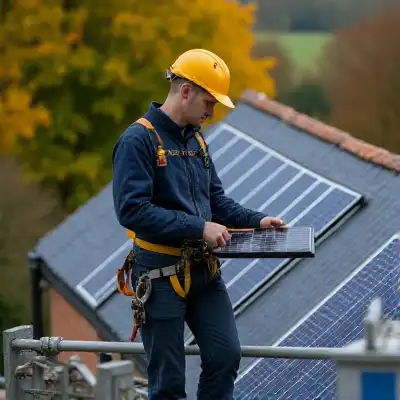DIY Solar Panel Installation: Can You Really Save Money?

With renewable energy becoming more accessible and popular, many homeowners are considering solar panels to cut down on electricity costs and reduce their environmental impact. But is DIY solar panel installation a viable way to save money, or are the potential pitfalls too significant to ignore? In this guide, we’ll break down the pros and cons, the steps involved, and whether you can truly achieve cost savings by going the DIY route.
Table of Contents
The Financial Appeal of DIY Solar Panel Installation
One of the primary motivators for considering a DIY solar panel installation is cost savings. On average, a professionally installed residential solar system can cost between $15,000 and $25,000. A significant portion of that expense comes from labor and professional services. By opting for a DIY approach, you could potentially save 30-50% of the installation cost.
Upfront Savings
No Labor Costs: Professional labor can account for thousands of dollars in installation fees.
Control Over Equipment: DIY kits allow you to shop around for affordable solar panels and inverters.
Federal and State Incentives: You’re still eligible for tax credits and rebates, such as the 30% federal solar tax credit, even if you install the system yourself.
However, these savings come with trade-offs that are important to consider.
The Challenges of DIY Solar Panel Installation
While the financial benefits are attractive, there are significant challenges and risks associated with installing solar panels on your own.
Technical Expertise Required
Installing solar panels is not a simple weekend project. It requires knowledge of:
Electrical wiring
Roof structural integrity
Local building codes and regulations
Safety Concerns
Working on rooftops can be dangerous without proper safety equipment.
Handling electrical components improperly can lead to shocks or fire hazards.
Warranty and Insurance Issues
Many solar panel manufacturers void warranties if the installation is not done by a certified professional.
DIY installations may not be covered under home insurance policies, leaving you vulnerable to potential damages.
Time Commitment
A professional team can install a solar system in a day or two, while a DIY installation could take weeks, depending on your experience level.
Step-by-Step Guide to DIY Solar Panel Installation
If you’ve weighed the pros and cons and decided to proceed, here’s a simplified overview of the installation process:
1. Assess Your Energy Needs
Review your electricity bills to determine your average monthly energy consumption.
Calculate the size of the solar system needed to meet your energy demands.
2. Choose the Right Solar Kit
Opt for a DIY solar panel kit that includes panels, inverters, racking, and wiring.
Compare brands for efficiency, durability, and warranty terms.
3. Evaluate Your Roof
Ensure your roof is structurally sound and has enough space to accommodate the panels.
Check for shading issues that could affect panel efficiency.
4. Obtain Necessary Permits
Contact your local government to understand permitting requirements.
Submit your solar system design for approval.
5. Install Mounting and Racking
Secure the racking system to your roof according to the kit instructions.
Ensure the mounting system is angled correctly to maximize sun exposure.
6. Install Solar Panels
Attach the panels to the racking system.
Use proper safety gear and follow the manufacturer’s guidelines.
7. Connect the Electrical Components
Wire the panels to the inverter and connect the inverter to your home’s electrical system.
Consider hiring an electrician for this step to ensure compliance with safety standards.
8. Inspection and Activation
Schedule a final inspection to ensure your system meets local codes.
Once approved, activate your solar panels and monitor their performance.
How Much Can You Save?
The amount you can save with DIY solar panel installation depends on several factors:
Cost Breakdown
DIY Solar Kit: $5,000 – $10,000
Permits and Inspections: $500 – $2,000
Optional Electrician Services: $500 – $1,500
Savings Over Time
DIY systems typically pay for themselves within 5–10 years, depending on energy usage and local electricity rates.
Homeowners can save $600–$1,000 annually on electricity bills.
Hidden Costs
Repairs and maintenance, especially if the installation is not done correctly.
Loss of time due to troubleshooting or delays in the installation process.
Professional Installation vs. DIY: What’s the Better Option?
To help you decide, here’s a side-by-side comparison:
| Aspect | Professional Installation | DIY Installation |
|---|---|---|
| Cost | $15,000 – $25,000 | $5,000 – $10,000 |
| Time | 1–3 days | Several weeks |
| Warranty | Typically included | May be voided |
| Expertise Required | None | High |
| Risk | Low | High |
Tips for a Successful DIY Solar Project
If you’re committed to DIY solar panel installation, follow these tips to ensure success:
Research Thoroughly: Understand your local codes, weather conditions, and energy requirements.
Invest in Quality Equipment: Don’t cut corners on panels, inverters, or safety gear.
Seek Professional Help When Needed: Consider hiring an electrician for wiring and inspection.
Monitor Performance: Use a solar monitoring system to track energy production and identify issues.
Conclusion: Is DIY Solar Worth It?
DIY solar panel installation can be a cost-effective way to embrace renewable energy, but it’s not without challenges. While you can save thousands of dollars upfront, the risks of improper installation and potential hidden costs should not be overlooked. For those with the technical skills, time, and determination, DIY solar can be a rewarding project. However, if you prioritize convenience and long-term reliability, professional installation might be the better investment.
By understanding the pros and cons and carefully planning your project, you can make an informed decision that aligns with your budget, skills, and sustainability goals.